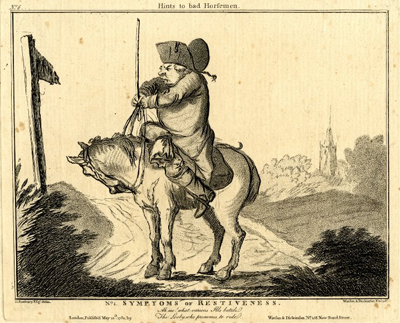Henry William Bunbury*
The younger son of a baronet, William Henry Bunbury was early recognized as having a talent for art. And indeed he was serious enough in his interest to study in Rome for a year after he left Cambridge. Like many young Englishmen, he encountered caricature while he was in Italy becoming himself the subject of two caricatures by Thomas Patch in 1769.
His first attempts at caricature fall very much within the Italian tradition of full length studies, mostly in profile, and were etched and published usually by other artists during the macaroni craze. But as his skill increased, his figures became less two-dimensional, and the backgrounds behind them more complete and realistic. And even when there might have been a specific person being portrayed, Bunbury's titles and interest lean towards portaying a social or ethnic type, e.g. Snip Francois, Snip Anglois, Postiglione Germanico, Postiglione Inglese, Peasant of the Alps.

Postiglione Germanico [1772]
© Trustees of the British Museum
Unlike Patch or Townshend, Bunbury seems to have early recognized the humorous potential of caricature, its capacity to both exaggerate and deflate. And his skill in capturing gesture and expression in prints like Billiards [1780], A Family Piece [1781], and in series like Hints to Bad Horsemen [1781] anticipates Rowlandson.

Symptoms of Restiveness [1781]
© Trustees of the British Museum
* The best account of Bunbury and his work that I know is John Reily's Henry William Bunbury: The Amateur as Caricaturist which forms the Introduction to the exhibition catalogue from the 1983 exhibit, Henry William Bunbury at Gainsborough's House.